How to remove the Datzbro banking trojan from your Android device
TrojanAlso Known As: Datzbro malware
Get free scan and check if your device is infected.
Remove it nowTo use full-featured product, you have to purchase a license for Combo Cleaner. Seven days free trial available. Combo Cleaner is owned and operated by RCS LT, the parent company of PCRisk.com.
What kind of malware is Datzbro?
Datzbro is a malware classed as a banking trojan. This malicious program is designed to infect Android devices. It has many harmful capabilities, including those associated with remote access/control, spying, and financial fraud.
Datzbro's code suggests that its developers were Chinese speakers. Initially, this trojan was used to target Chinese users. It is believed that this malware has been leaked and is now used by multiple cyber criminals and threat actor groups. The latest Datzbro campaign has been active since at least the late summer of 2025, targeting senior users via fake Facebook Groups.
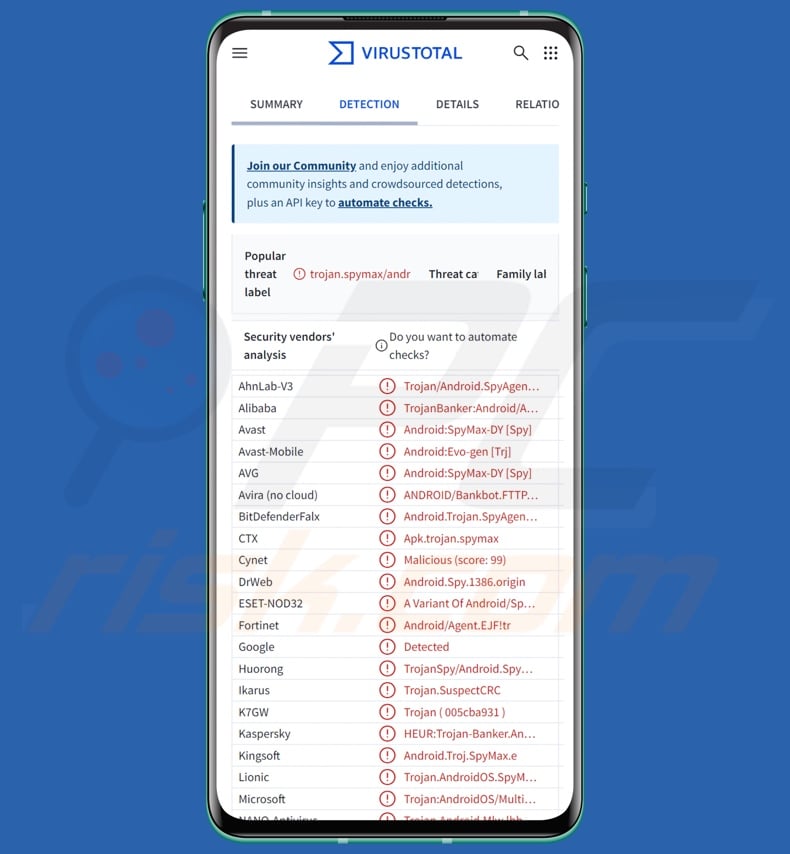
Datzbro malware overview
Datzbro is a versatile trojan developed with an emphasis on applications related to banking and digital assets (like cryptocurrency wallets). This malware relies on the abuse of the Android Accessibility Services to carry out many of its malicious activities.
The Accessibility Services offer additional aid with device interaction to users who require it. Their capabilities are extensive – e.g., reading the screen, interacting with the touchscreen, simulating the keyboard, etc. Thus, malware that abuses these services accesses all their functionalities.
Datzbro is not only a banking trojan; it also shares similarities with Remote Access Trojans (RATs) and spyware. This program can enable remote access and control over compromised devices. It utilizes dark-screen overlays to hide its activities. The transparency of the screen and whether anything is displayed on it – can be customized. The overlay may contain text or other graphics imitating legitimate processes (e.g., updates, boot screens, etc.).
Datzbro can live-stream the victim's screen, yet if an issue is encountered with this feature, the infected device's interface recreated on the attacker's end aids with tracking/performing remote activities. Unlike many banking trojans, this program does not employ phishing overlays (e.g., fake screens overlaying genuine apps mimicking sign-in, payment, and similar pages).
Aside from screen streaming/recording, Datzbro's spyware-adjacent features include recording audio via the device's microphone, taking snapshots and recording via the device's cameras, switching between the front/back cameras, and keylogging (keystroke recording).
The trojan collects extensive data, such as relevant device details, installed app list, folders/files, albums/photos, contacts list, and text messages. Datzbro has managing functionalities as well: it can run and remove applications; read, create, rename, and delete files; exfiltrate (download) and delete photos; add, modify, and delete contacts; filter, delete, and send SMSes (the latter could be used for Toll Fraud malware purposes).
This malware does not merely passively collect sensitive information through keylogging, as it can display prompts requesting victims to provide specific data. Datzbro targets log-in credentials for the device (i.e., lock pattern/PIN/password), Alipay, and WeChat. It searches for packages containing certain keywords, e.g., "bank", "finance", "pay", "wallet", etc. The program also tracks instances when it encounters the terms "password", "PIN/ verification code", and "code/verify" in English and Chinese.
It must be mentioned that malware developers/ attackers often improve upon their software and methodologies. Therefore, possible future iterations of Datzbro might have a different target list or streamlined/additional functionalities.
To summarize, the presence of malicious software like Datzbro on devices can result in severe privacy issues, financial losses, and identity theft.
| Name | Datzbro malware |
| Threat Type | Android malware, malicious application, banking trojan. |
| Detection Names | Avast-Mobile (Android:Evo-gen [Trj]), Combo Cleaner (Android.Trojan.SpyAgent.RV), ESET-NOD32 (A Variant Of Android/Spy.Agent.EJF), Kaspersky (HEUR:Trojan-Banker.AndroidOS.Agent.ws), Full List (VirusTotal) |
| Symptoms | The device is running slow, system settings are modified without user's permission, questionable applications appear, data and battery usage is increased significantly. |
| Distribution methods | Infected email attachments, malicious online advertisements, social engineering, deceptive applications, scam websites. |
| Damage | Stolen personal information (private messages, logins/passwords, etc.), decreased device performance, battery is drained quickly, decreased Internet speed, huge data losses, monetary losses, stolen identity (malicious apps might abuse communication apps). |
| Malware Removal (Windows) |
To eliminate possible malware infections, scan your computer with legitimate antivirus software. Our security researchers recommend using Combo Cleaner. Download Combo CleanerTo use full-featured product, you have to purchase a license for Combo Cleaner. 7 days free trial available. Combo Cleaner is owned and operated by RCS LT, the parent company of PCRisk.com. |
Android-specific banking trojan examples
RedHook, PhantomCard, and DoubleTrouble are merely a couple of our latest articles on banking trojans. It is not uncommon for financially-motivated malware to possess a variety of capabilities, which would enable its use in different capacities.
Remember that regardless of how malware operates, its presence on a system threatens device integrity and user safety. Hence, all threats must be removed immediately upon detection.
How did Datzbro infiltrate my device?
Evidence suggests that initially, Datzbro was used by multiple threat actors to target Chinese-speaking users. The campaign detected in August 2025 comprised sophisticated social engineering scams targeting users in Australia, Canada, Malaysia, Singapore, South Africa, and the United Kingdom. It is speculated that the same entity is behind these scams due to their extensive similarities.
To expand upon this activity, the campaigns targeting Australians were facilitated via fake Groups on the Facebook social networking platform. These Facebook Groups were geared towards seniors and promoted "active senior trips", meetups, activities, dances, and the like. The content utilized and posted by the Groups utilized generative AI.
Facebook users interested in these Groups were contacted by cyber criminals directly (via Messenger, WhatsApp, etc.) and urged to download/install a community app. The links shared by the criminals led to deceptive websites endorsing the malicious application as an app for registering and tracking senior events, contacting fellow members, etc. However, there were some instances where victims were first lured to visit phishing sites targeting credit/debit card details under the guise of collecting sign-up fees.
The bogus "Google Play" option on the malicious webpages led victims to infect their devices with Datzbro. In some instances, this trojan infiltrated devices through a dropper malware capable of bypassing the security measures implemented in Android 13 and later versions – predominantly via Zombinder.
At the time of writing, the fake Apple "App Store" option did not result in a download or redirect. However, keep in mind that this could be rectified (i.e., download an iOS-compatible malware, redirect to a phishing page, etc.).
As mentioned previously, Datzbro's C&C (Command and Control) application and builder have been leaked, meaning that it is accessible to various unaffiliated cyber criminals. Hence, this malware is likely proliferated using different tactics and methods.
In general, malicious software is distributed via untrustworthy download sources (e.g., freeware and free file-hosting websites, P2P sharing networks, third-party app stores, etc.), drive-by (stealthy/deceptive) downloads, malvertising, online scams, malicious attachments/links in spam mail (e.g., emails, DMs/PMs, SMSes, etc.), pirated content, illegal activation ("cracking") tools, and fake updates.
Some malicious programs can even self-spread through local networks and removable storage devices (e.g., external hard drives, USB flash drives, etc.).
How to avoid installation of malware?
Caution is paramount to ensuring device and user safety. Therefore, always research software prior to downloading/purchasing by reading terms and user/expert reviews, exploring required permissions, and verifying developer legitimacy. Download only from official and trustworthy channels.
Activate and update programs using legitimate functions/tools, as those acquired from third-parties may contain malware. Be vigilant when browsing since the Internet is full of deceptive and malicious content. Be careful with incoming emails and other messages; do not open attachments or links found in suspicious/irrelevant communications.
It is essential to have a reputable antivirus installed and kept updated. Security software must be used to perform regular system scans and to remove detected threats and issues.
Fake Facebook groups targeting senior users in Australia (image source – ThreatFabric):

Malicious websites spreading Datzbro under the guise of senior-centered apps (image source – ThreatFabric):
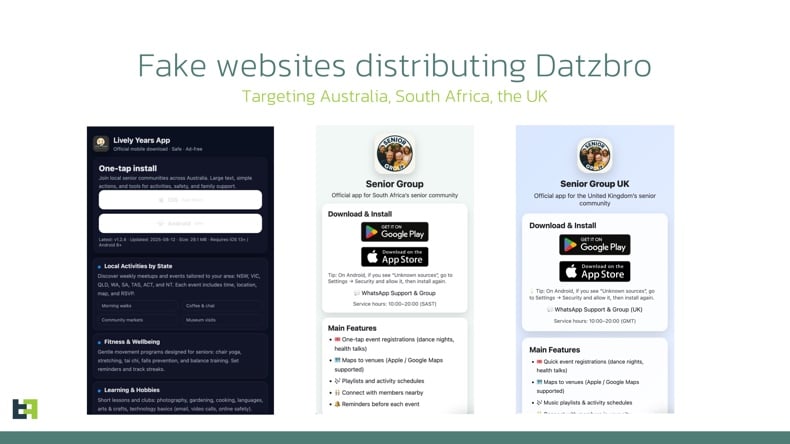
Quick menu:
- Introduction
- How to delete browsing history from the Chrome web browser?
- How to disable browser notifications in the Chrome web browser?
- How to reset the Chrome web browser?
- How to delete browsing history from the Firefox web browser?
- How to disable browser notifications in the Firefox web browser?
- How to reset the Firefox web browser?
- How to uninstall potentially unwanted and/or malicious applications?
- How to boot the Android device in "Safe Mode"?
- How to check the battery usage of various applications?
- How to check the data usage of various applications?
- How to install the latest software updates?
- How to reset the system to its default state?
- How to disable applications that have administrator privileges?
Delete browsing history from the Chrome web browser:
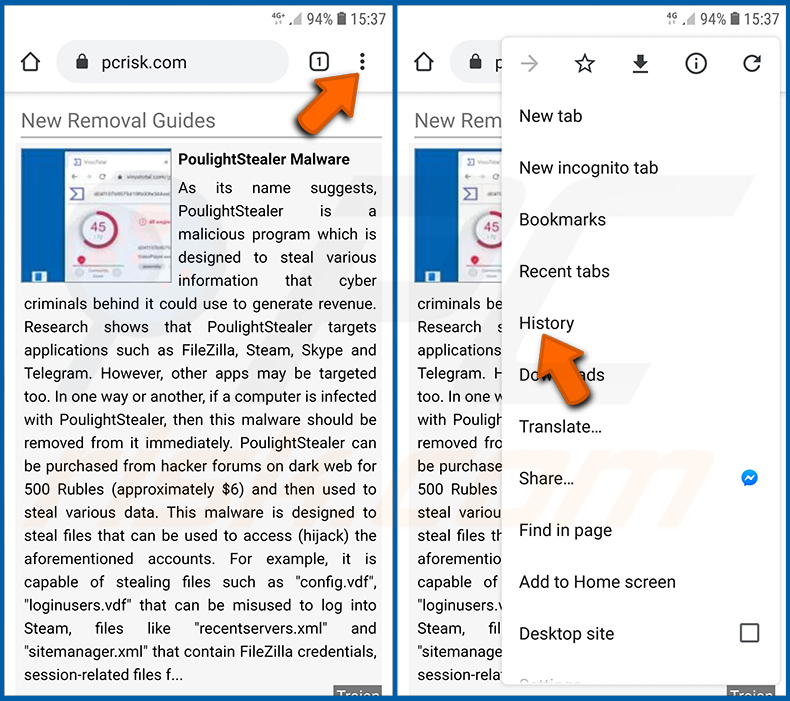
Tap the "Menu" button (three dots on the right-upper corner of the screen) and select "History" in the opened dropdown menu.
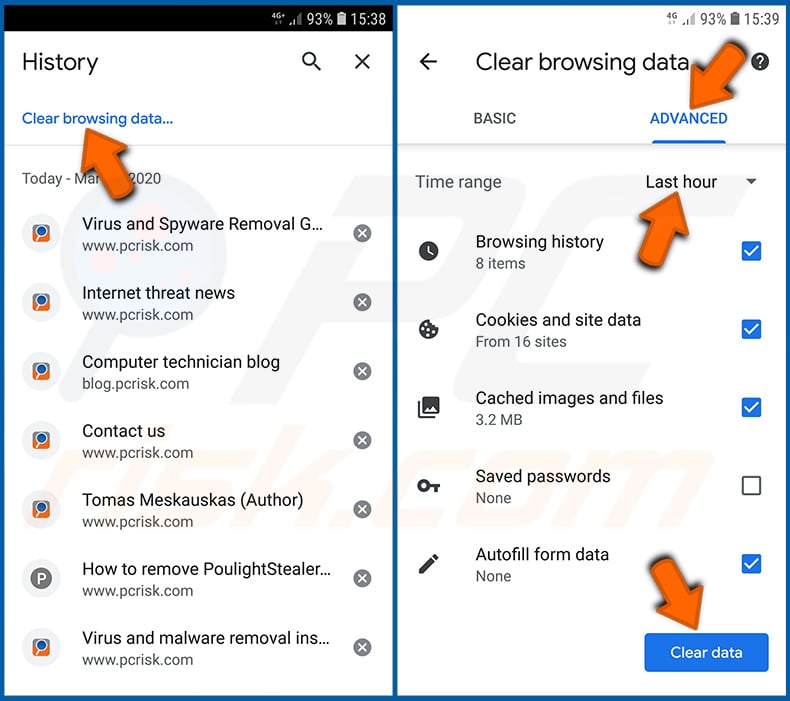
Tap "Clear browsing data", select "ADVANCED" tab, choose the time range and data types you want to delete and tap "Clear data".
Disable browser notifications in the Chrome web browser:
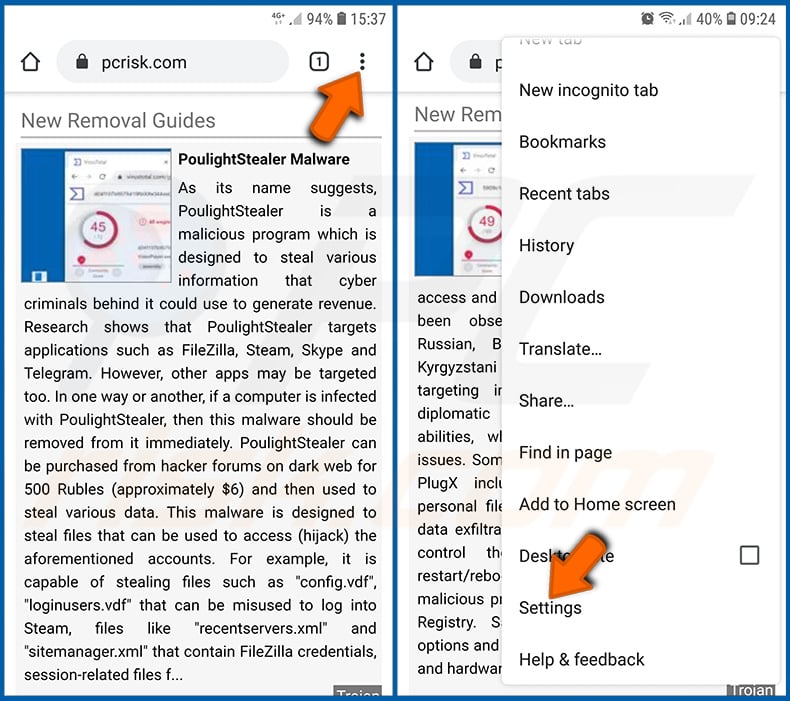
Tap the "Menu" button (three dots on the right-upper corner of the screen) and select "Settings" in the opened dropdown menu.
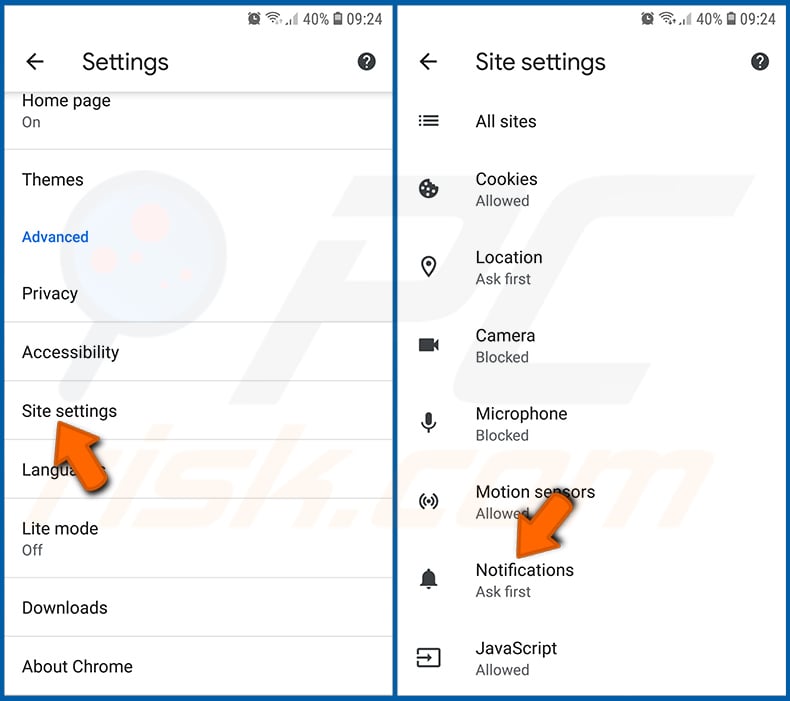
Scroll down until you see "Site settings" option and tap it. Scroll down until you see "Notifications" option and tap it.
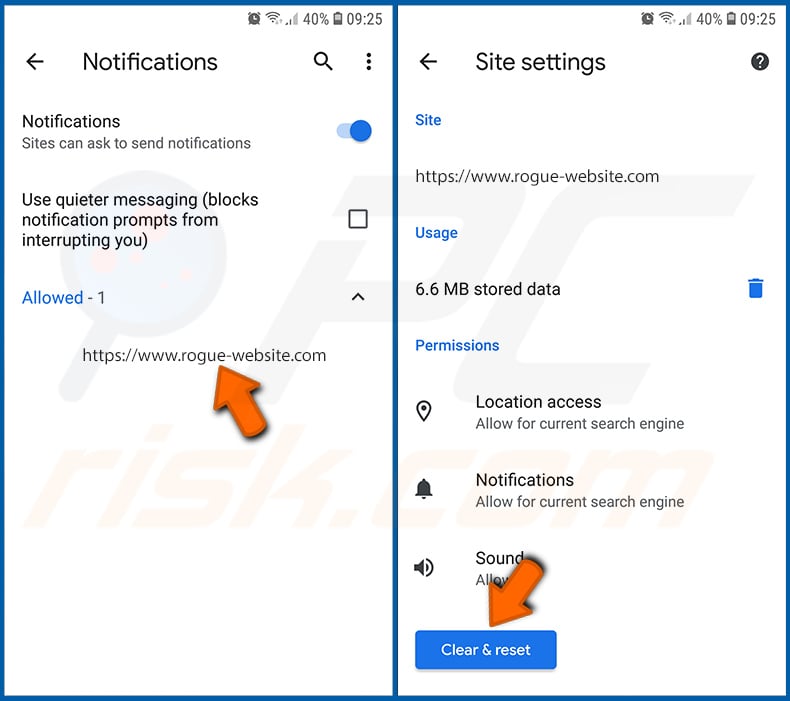
Find the websites that deliver browser notifications, tap on them and click "Clear & reset". This will remove permissions granted for these websites to deliver notifications. However, once you visit the same site again, it may ask for a permission again. You can choose whether to give these permissions or not (if you choose to decline the website will go to "Blocked" section and will no longer ask you for the permission).
Reset the Chrome web browser:
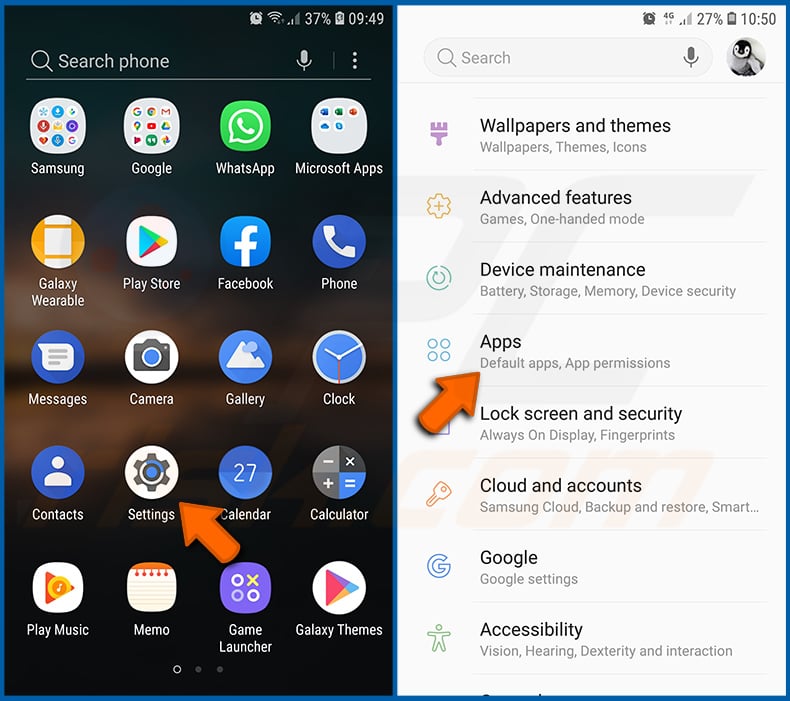
Go to "Settings", scroll down until you see "Apps" and tap it.
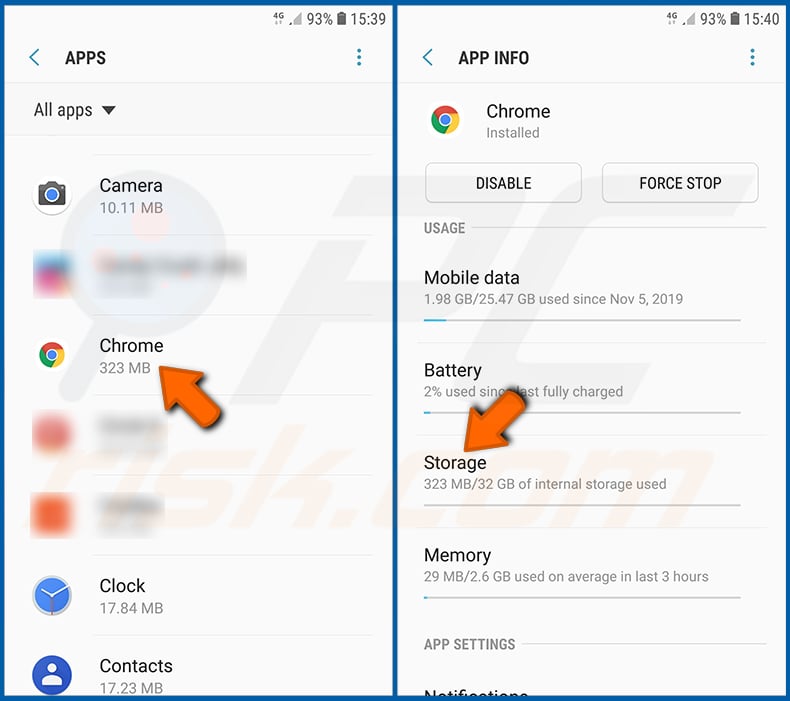
Scroll down until you find "Chrome" application, select it and tap "Storage" option.
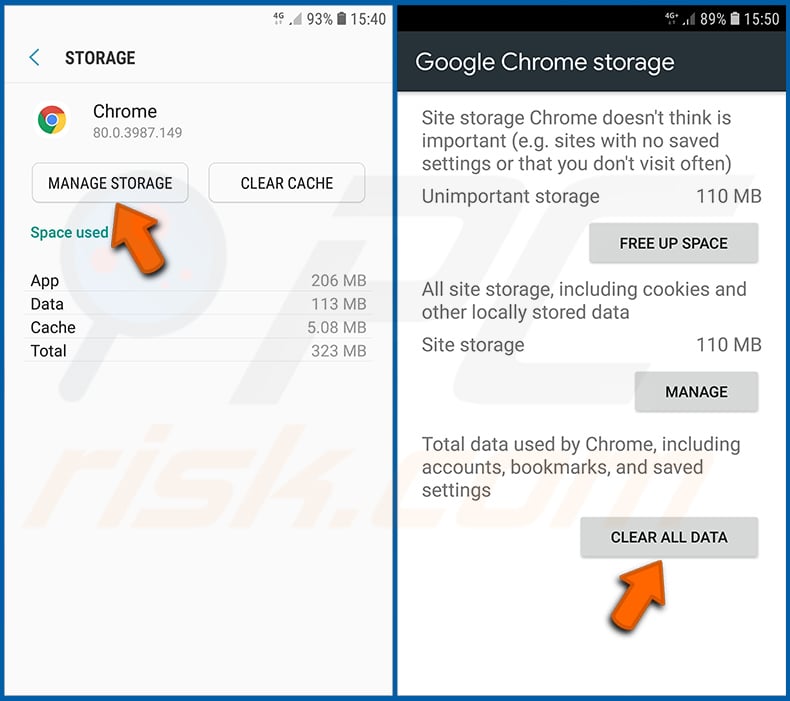
Tap "MANAGE STORAGE", then "CLEAR ALL DATA" and confirm the action by taping "OK". Note that resetting the browser will eliminate all data stored within. This means that all saved logins/passwords, browsing history, non-default settings and other data will be deleted. You will also have to re-login into all websites as well.
Delete browsing history from the Firefox web browser:
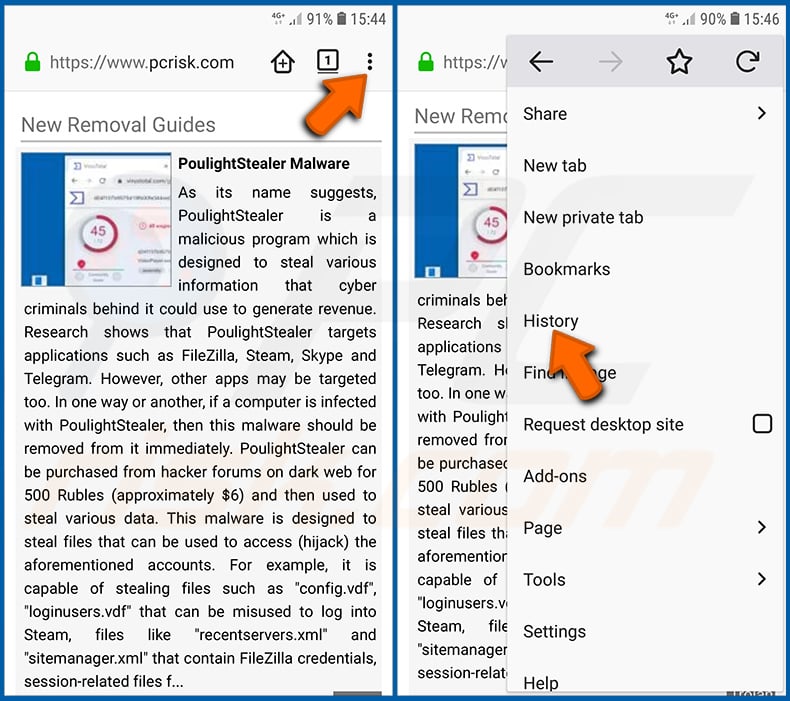
Tap the "Menu" button (three dots on the right-upper corner of the screen) and select "History" in the opened dropdown menu.
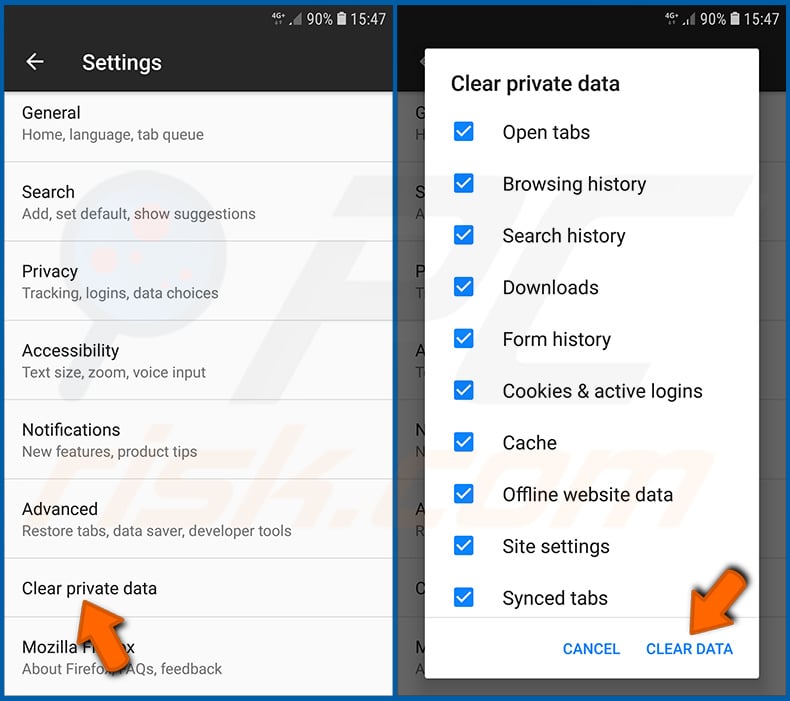
Scroll down until you see "Clear private data" and tap it. Select data types you want to remove and tap "CLEAR DATA".
Disable browser notifications in the Firefox web browser:
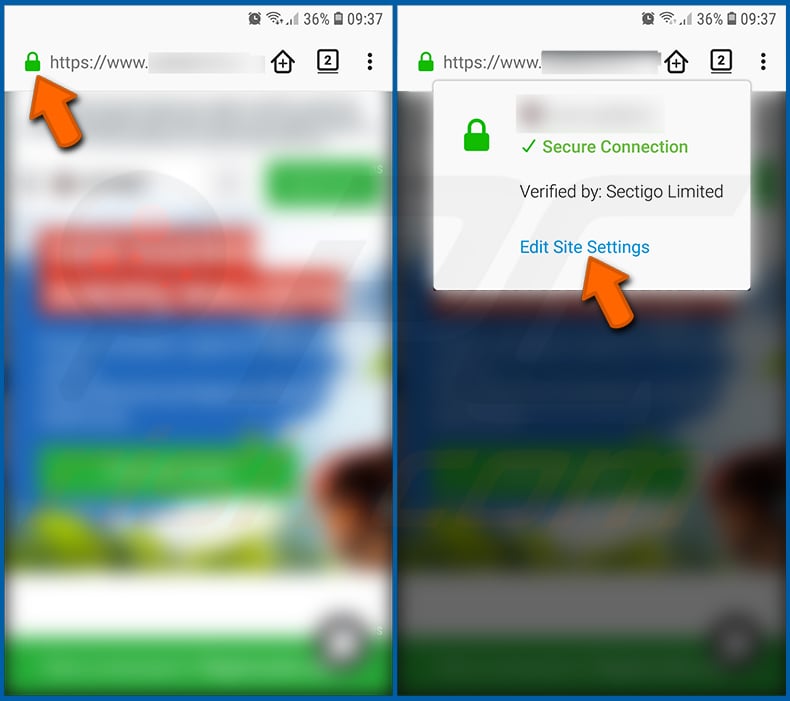
Visit the website that is delivering browser notifications, tap the icon displayed on the left of URL bar (the icon will not necessarily be a "Lock") and select "Edit Site Settings".
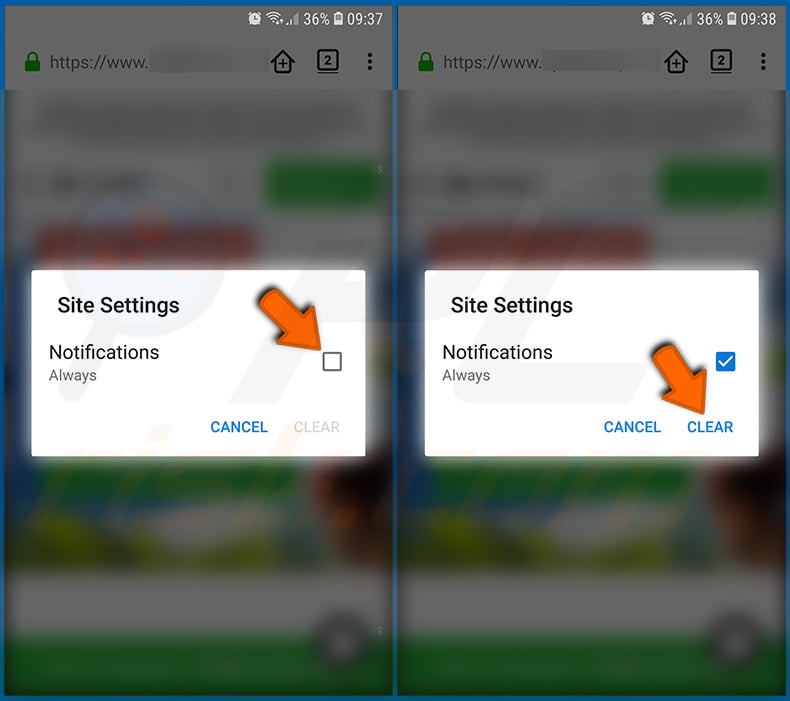
In the opened pop-up opt-in the "Notifications" option and tap "CLEAR".
Reset the Firefox web browser:
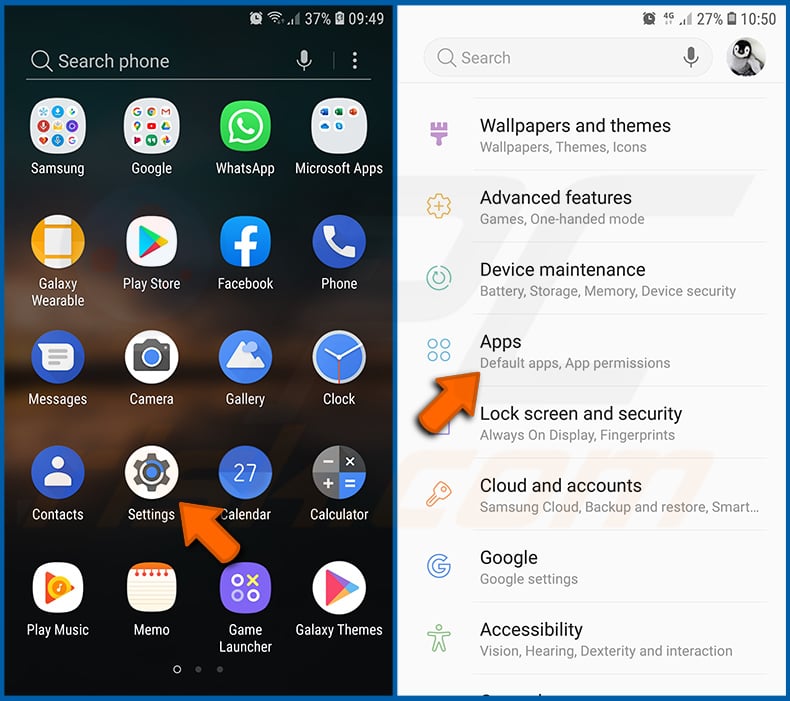
Go to "Settings", scroll down until you see "Apps" and tap it.
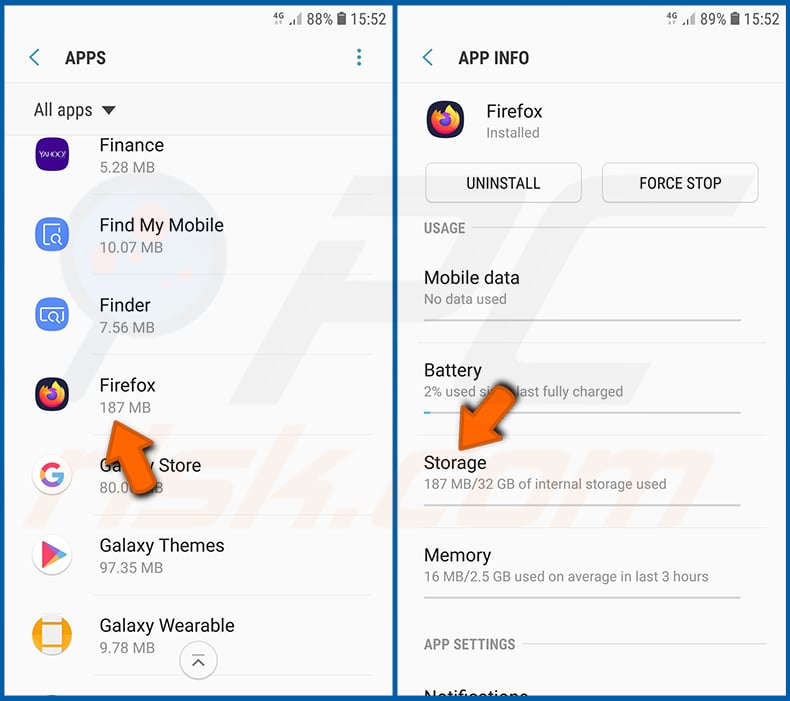
Scroll down until you find "Firefox" application, select it and tap "Storage" option.
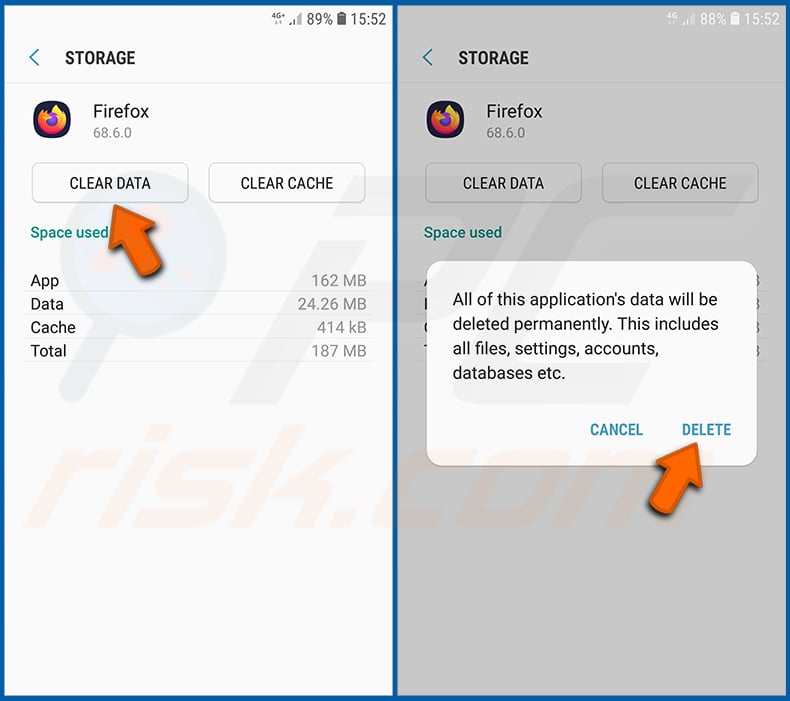
Tap "CLEAR DATA" and confirm the action by taping "DELETE". Note that resetting the browser will eliminate all data stored within. This means that all saved logins/passwords, browsing history, non-default settings and other data will be deleted. You will also have to re-login into all websites as well.
Uninstall potentially unwanted and/or malicious applications:
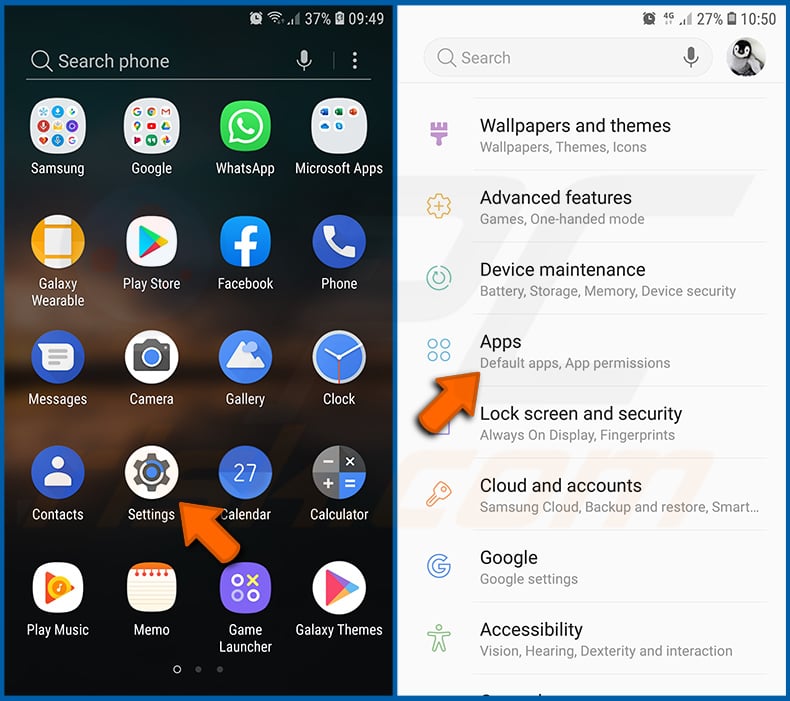
Go to "Settings", scroll down until you see "Apps" and tap it.
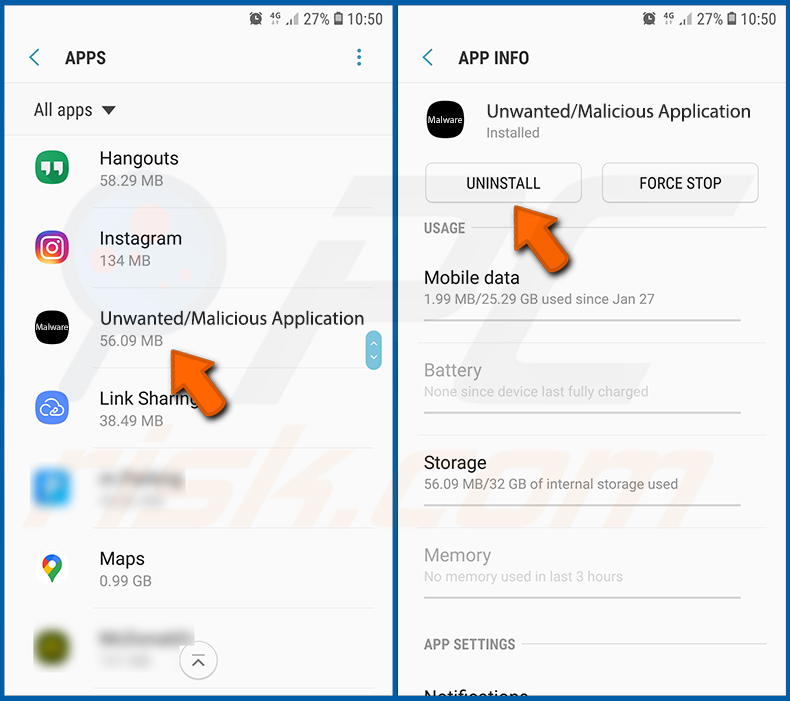
Scroll down until you see a potentially unwanted and/or malicious application, select it and tap "Uninstall". If, for some reason, you are unable to remove the selected app (e.g., you are prompted with an error message), you should try using the "Safe Mode".
Boot the Android device in "Safe Mode":
The "Safe Mode" in Android operating system temporarily disables all third-party applications from running. Using this mode is a good way to diagnose and solve various issues (e.g., remove malicious applications that prevent users you from doing so when the device is running "normally").
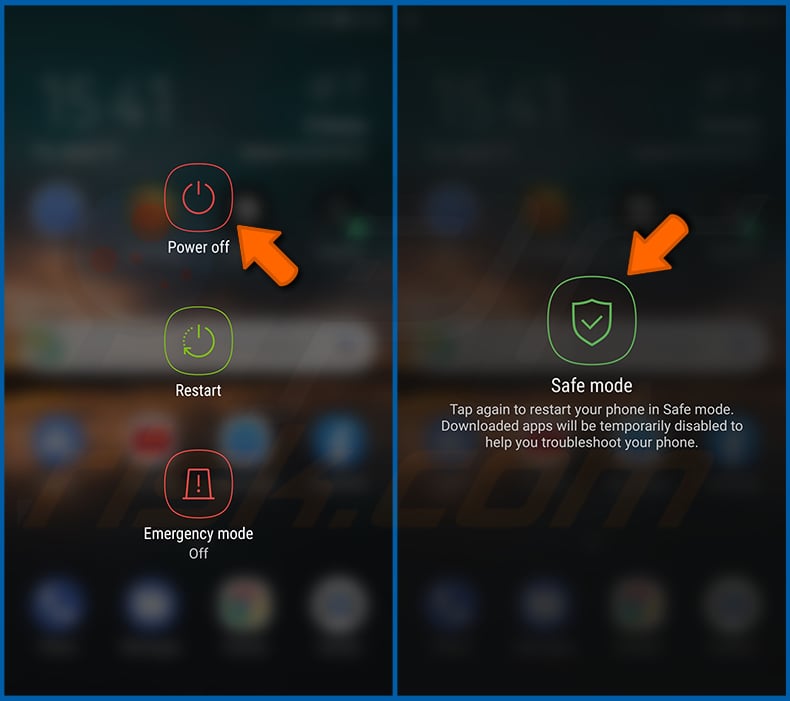
Push the "Power" button and hold it until you see the "Power off" screen. Tap the "Power off" icon and hold it. After a few seconds the "Safe Mode" option will appear and you'll be able run it by restarting the device.
Check the battery usage of various applications:
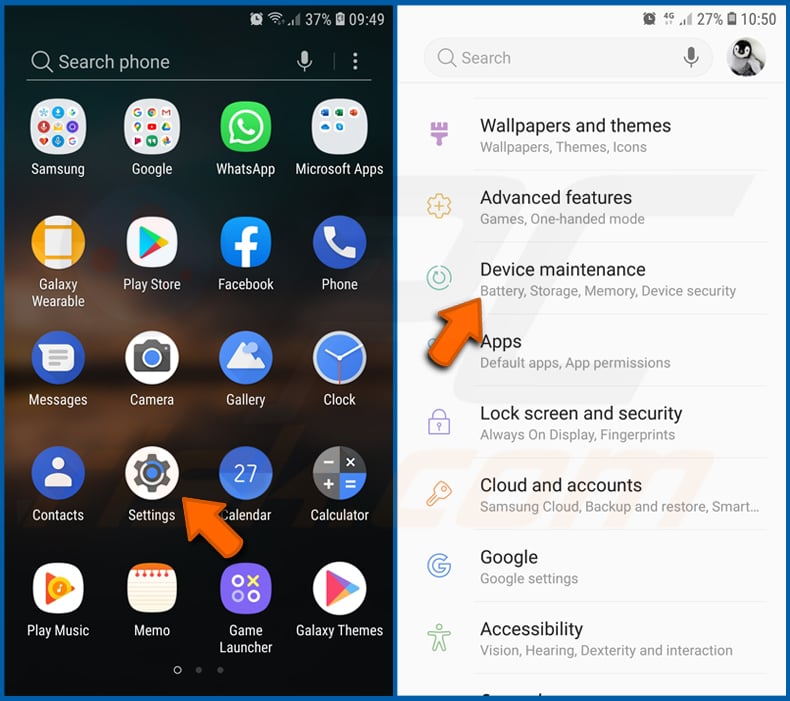
Go to "Settings", scroll down until you see "Device maintenance" and tap it.
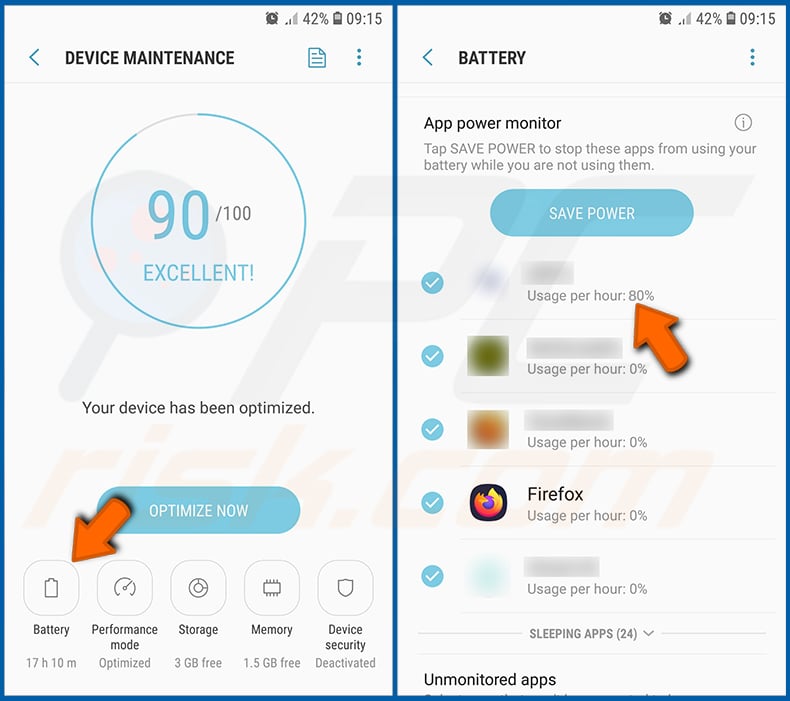
Tap "Battery" and check the usage of each application. Legitimate/genuine applications are designed to use as low energy as possible in order to provide the best user experience and to save power. Therefore, high battery usage may indicate that the application is malicious.
Check the data usage of various applications:
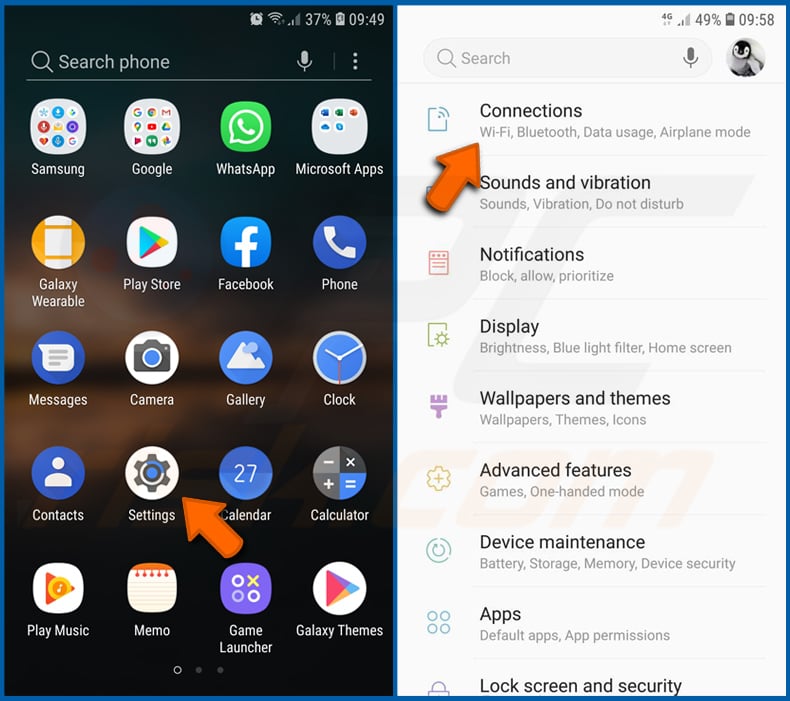
Go to "Settings", scroll down until you see "Connections" and tap it.
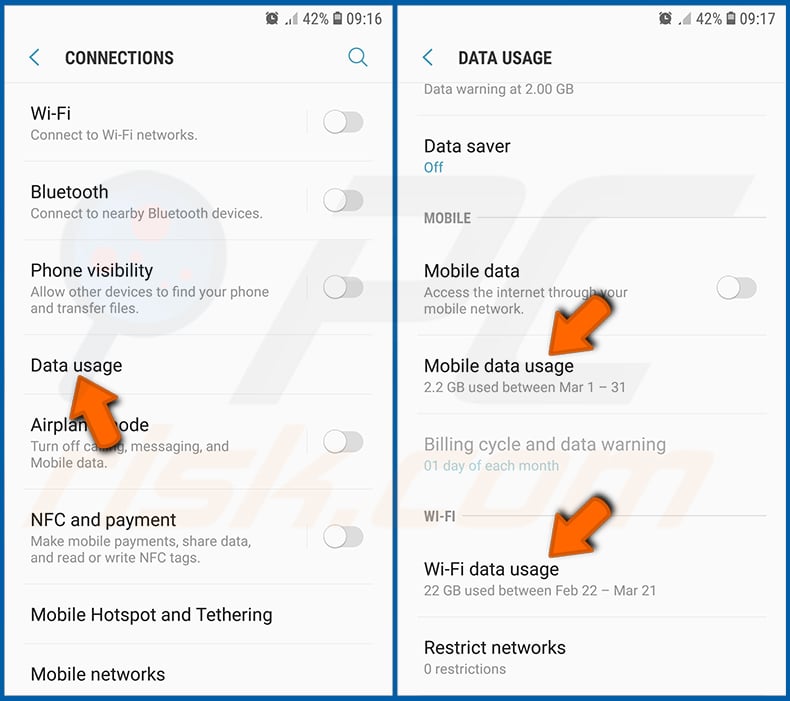
Scroll down until you see "Data usage" and select this option. As with battery, legitimate/genuine applications are designed to minimize data usage as much as possible. This means that huge data usage may indicate presence of malicious application. Note that some malicious applications might be designed to operate when the device is connected to wireless network only. For this reason, you should check both Mobile and Wi-Fi data usage.
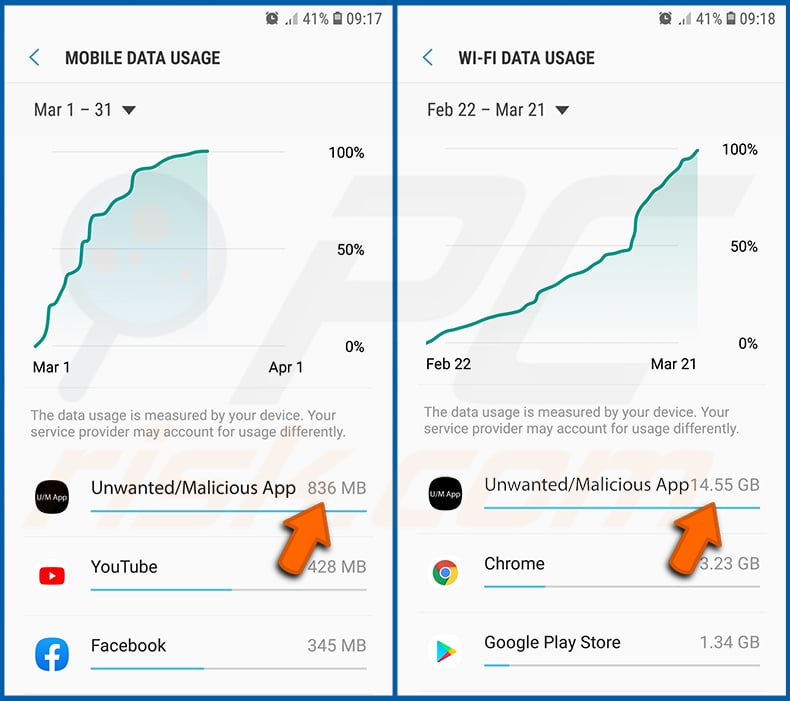
If you find an application that uses a lot of data even though you never use it, then we strongly advise you to uninstall it as soon as possible.
Install the latest software updates:
Keeping the software up-to-date is a good practice when it comes to device safety. The device manufacturers are continually releasing various security patches and Android updates in order to fix errors and bugs that can be abused by cyber criminals. An outdated system is way more vulnerable, which is why you should always be sure that your device's software is up-to-date.
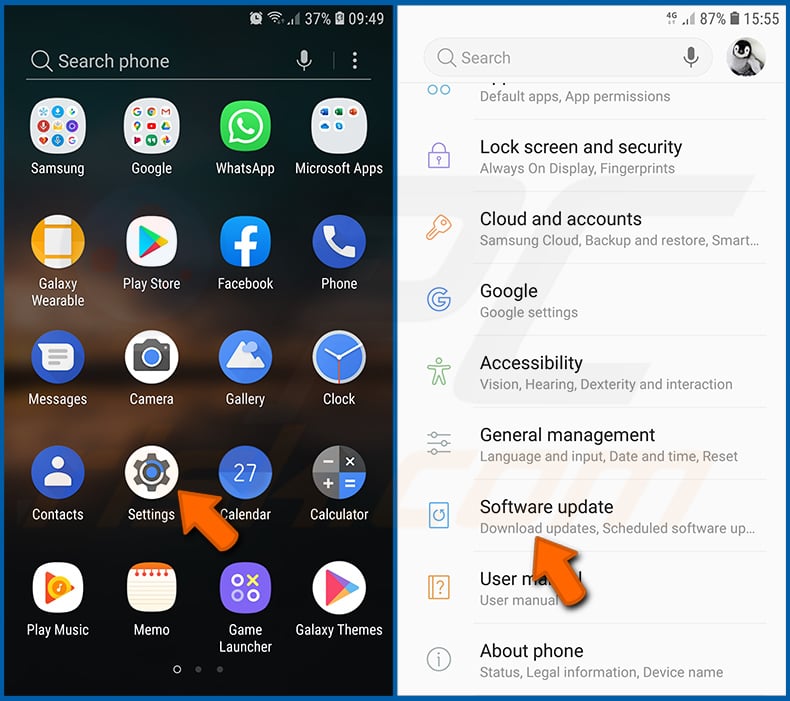
Go to "Settings", scroll down until you see "Software update" and tap it.
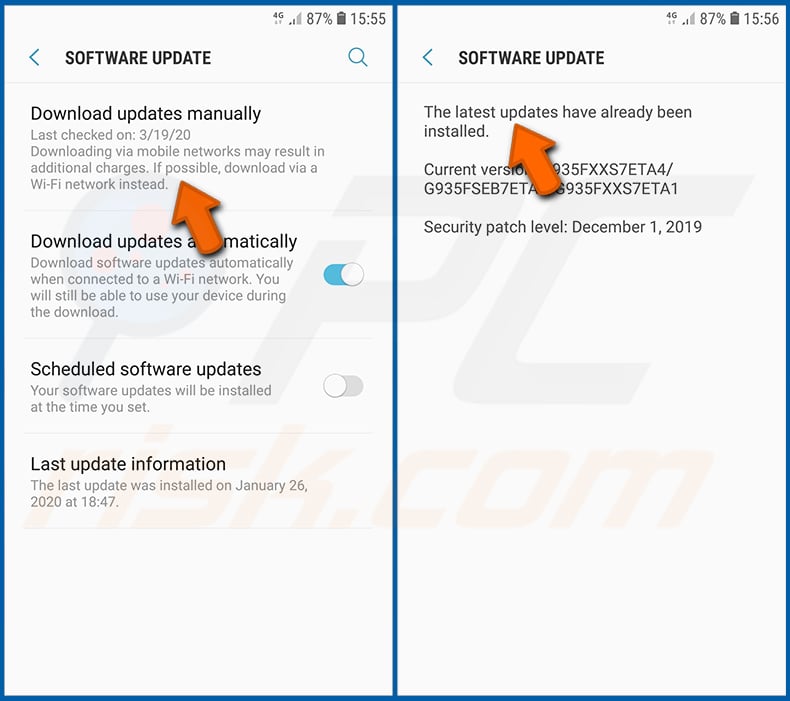
Tap "Download updates manually" and check if there are any updates available. If so, install them immediately. We also recommend to enable the "Download updates automatically" option - it will enable the system to notify you once an update is released and/or install it automatically.
Reset the system to its default state:
Performing a "Factory Reset" is a good way to remove all unwanted applications, restore system's settings to default and clean the device in general. However, you must keep in mind that all data within the device will be deleted, including photos, video/audio files, phone numbers (stored within the device, not the SIM card), SMS messages, and so forth. In other words, the device will be restored to its primal state.
You can also restore the basic system settings and/or simply network settings as well.
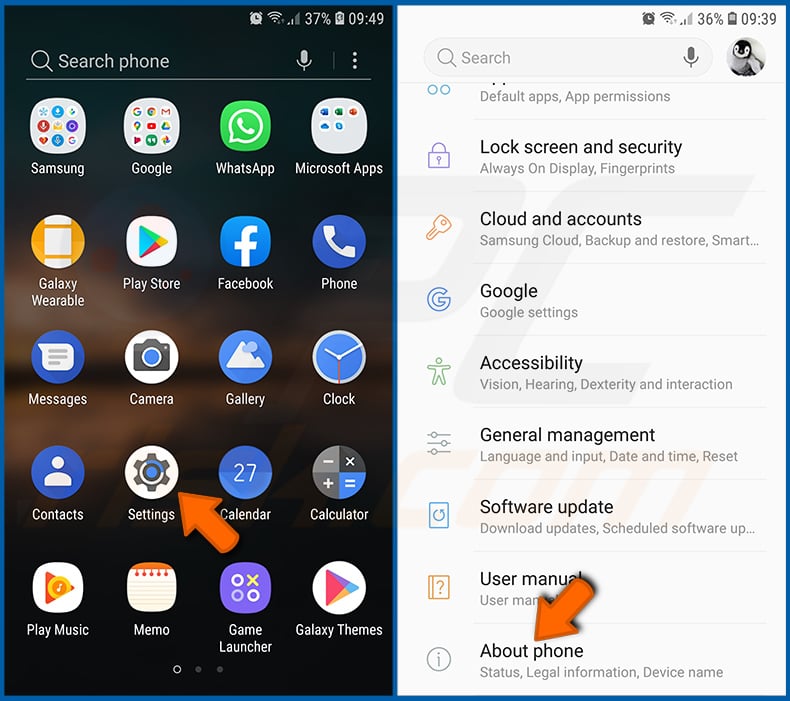
Go to "Settings", scroll down until you see "About phone" and tap it.
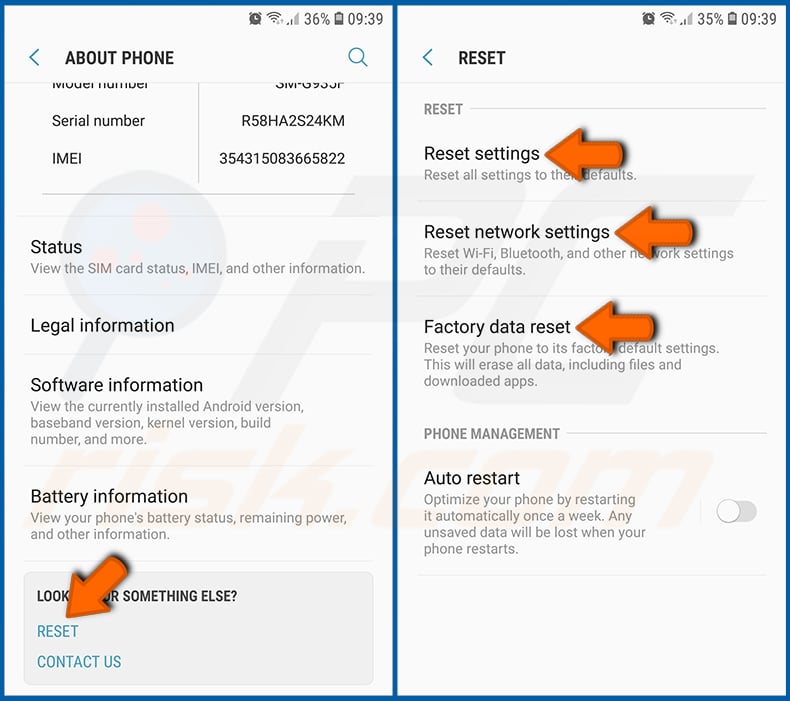
Scroll down until you see "Reset" and tap it. Now choose the action you want to perform:
"Reset settings" - restore all system settings to default;
"Reset network settings" - restore all network-related settings to default;
"Factory data reset" - reset the entire system and completely delete all stored data;
Disable applications that have administrator privileges:
If a malicious application gets administrator-level privileges it can seriously damage the system. To keep the device as safe as possible you should always check what apps have such privileges and disable the ones that shouldn't.
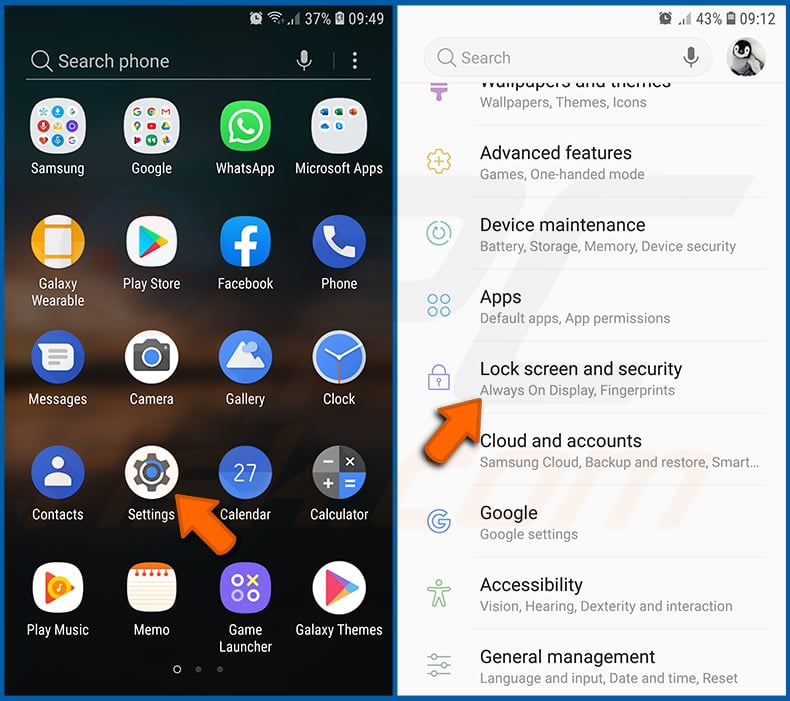
Go to "Settings", scroll down until you see "Lock screen and security" and tap it.
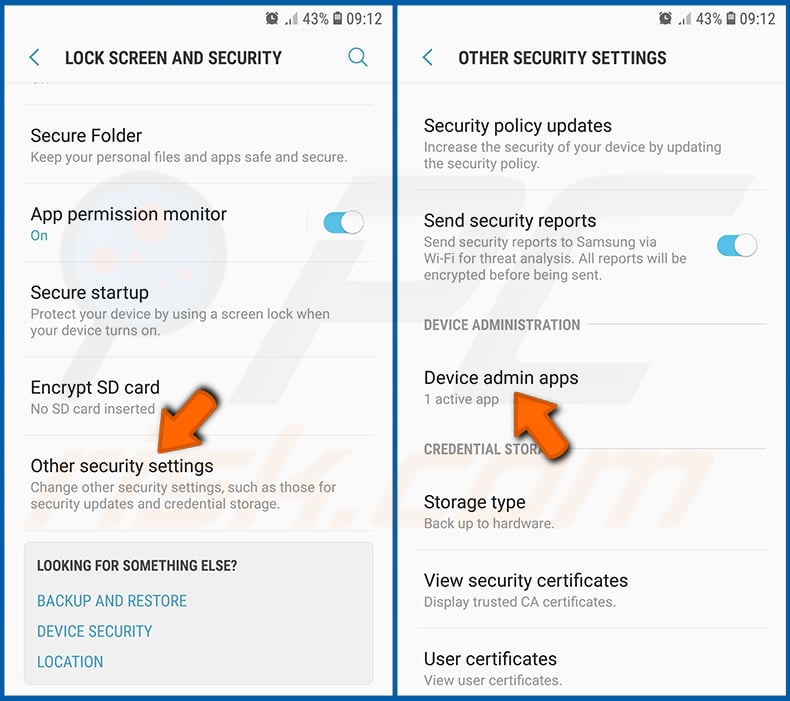
Scroll down until you see "Other security settings", tap it and then tap "Device admin apps".
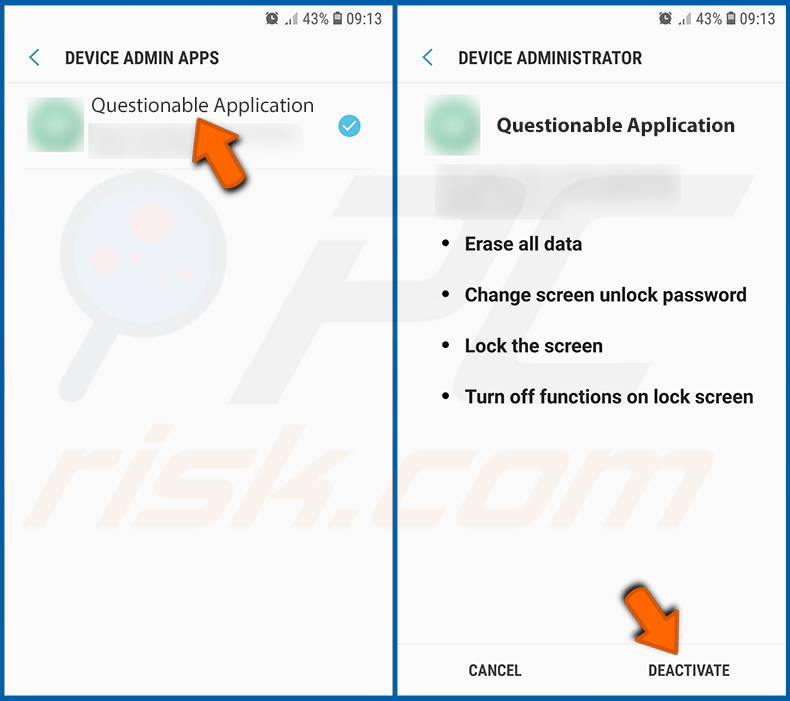
Identify applications that should not have administrator privileges, tap them and then tap "DEACTIVATE".
Frequently Asked Questions (FAQ)
My Android device is infected with Datzbro malware, should I format my storage device to get rid of it?
Malware removal rarely necessitates such drastic measures.
What are the biggest issues that Datzbro malware can cause?
The dangers posed by an infection depend on the malicious program's capabilities and the cyber criminals' modus operandi. Datzbro is a multifunctional program that specifically targets banking-related data. Infections of this kind can lead to serious privacy issues, financial losses, and identity theft.
What is the purpose of Datzbro malware?
Profit is the most common motivation behind malware attacks, and based on Datzbro's functionalities – it is no exception. However, malware can also be used to amuse the attackers or realize their personal grudges, disrupt processes (e.g., sites, services, companies, etc.), engage in hacktivism, and launch politically/geopolitically motivated attacks.
How did Datzbro malware infiltrate my Android device?
Datzbro has been spread through malicious sites promoted by fake Facebook Groups using lures centered on senior activities and events. Other distribution techniques are not unlikely.
Malware is most commonly spread via drive-by downloads, dubious download sources (e.g., freeware and free file-hosting sites, P2P sharing networks, third-party app stores, etc.), malvertising, online scams, spam, pirated programs/media, illegal software activation tools ("cracks"), and fake updates. Furthermore, some malicious programs can self-proliferate through local networks and removable storage devices.
Will Combo Cleaner protect me from malware?
Combo Cleaner is capable of detecting and eliminating practically all known malware infections. Remember that performing a full system scan is crucial since high-end malicious software tends to hide deep within systems.
Share:

Tomas Meskauskas
Expert security researcher, professional malware analyst
I am passionate about computer security and technology. I have an experience of over 10 years working in various companies related to computer technical issue solving and Internet security. I have been working as an author and editor for pcrisk.com since 2010. Follow me on Twitter and LinkedIn to stay informed about the latest online security threats.
PCrisk security portal is brought by a company RCS LT.
Joined forces of security researchers help educate computer users about the latest online security threats. More information about the company RCS LT.
Our malware removal guides are free. However, if you want to support us you can send us a donation.
DonatePCrisk security portal is brought by a company RCS LT.
Joined forces of security researchers help educate computer users about the latest online security threats. More information about the company RCS LT.
Our malware removal guides are free. However, if you want to support us you can send us a donation.
Donate
▼ Show Discussion